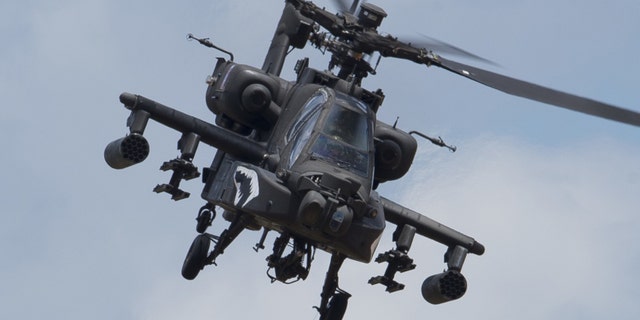Built to absorb some small arms fire, Apache attack helicopters can swoop into enemy fire to provide critical air support to ground infantry caught in lethal combat.
As part of this mission, the Army AH-64 Apache platform draws upon its long-range, high-fidelity sensors to detect new pockets of enemy forces closing in on the area, merges targeting and navigational data with nearby drones and Blackhawks, processes, analyzes and organizes otherwise disparate pools of crucial information and therefore offers ground commanders an integrated picture … in a matter of seconds.
Otherwise disconnected variables such as force location, terrain, navigational detail and enemy activity can be analyzed in relation to one another, massively easing the decision-making burden upon soldiers swarmed by enemy attack.
Should this transpire, Brigade Combat Team commanders could make faster, safer, more combat-effective decisions while facing fast-changing combat circumstances. The execution of this, however, of course, relies heavily on high-speed integrated computing technology intended to expedite information gathering, analysis and dissemination.
With these kinds of dynamics in mind, Raytheon weapons developers are testing an emerging technology called Common Open Secure Mission Computer (COSMC).
“The concept is to replace federated functional computer systems with a data-fusion architecture to handle multi-function needs, by bringing them together,” Stephanie Edmisten, Director, Trusted Mission Processing, Raytheon, told Warrior in an interview.
‘ATTACKING AT SPEED’: ARMY PROJECT CONVERGENCE AND BREAKTHROUGH LIGHTNING-FAST WAR
The execution of these kinds of applications can be brought to life through the engineering of common technical standards, IP protocols architected to easily integrate and upgrade data analysis, information sharing and cost-effective modernization, Raytheon developers explained.

Apache helicopter.
(1st Combat Camera Squadron, Photo by Tech. Sgt. Barry Loo)
“What we can do with COSMC is provide an open computing environment. We pulled the capabilities of legacy federated systems together to create a single consolidated computing platforms to host algorithms and information centrally and allow for post processing application data correlation,” John Stephens Product Line Manager, Secure Mission Processing, Raytheon, told Warrior in an interview.
There are also substantial combat networking implications, as an ability to more quickly share time-sensitive warfare information better enables “platform-to-platform sensor integration,” and “take advantage of common software standards. If you are running IP packets in some kind of baseline standard you can expedite platform to platform sensor integration,” as Stephens put it.
“Data can be containerized in a smart way so that when you build a mission computer you minimize the effort required to requalify or recertify,” he added.
Containerized software, among other things, refers to an ability to program computer operating systems to streamline and compartmentalize different functions simultaneously, yet without launching an entire machine for each app, according to the “Kubernetes” website.
NAVY ELECTRONIC WARFARE STOPS MULTIPLE ENEMY MISSILE ATTACKS AT ONCE
Kubernetes, a technical process referred to by Stephens, is a computer system for “automating application deployment, scaling and management.” Much of this is made possible through what’s called application containerization; it is defined as,an operating system-level “virtualization method used to deploy and run distributed applications,” according to Techtarget.com. Containerization enables multiple “isolated applications or services to run on a single host and access the same operating system.”
These technical phenomena closely mirror the intent and execution of COSMC, which, as Stephens articulated, “converges federated computing products into one box.”
CLICK HERE TO GET THE FOX NEWS APP
Applications such as these also, by design, lessen developmental costs and reduce the hardware footprint. Smaller form factors, capable of performing a wider range of computer processing and data organization functions, save on money as well as “size, weight and power” considerations, Stephens and Edmisten explained.
— Kris Osborn is the Managing Editor of Warrior Maven and The Defense Editor of The National Interest —








